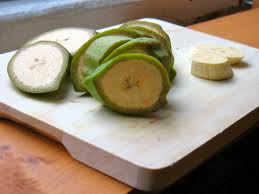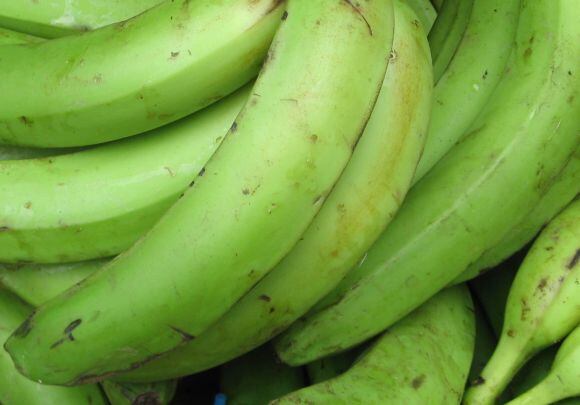In application #20130156893 published on June 20, 2013, and filed in December 2012, PepsiCo says unripe, unpeeled green bananas contain more starch - especially resistant starch - and less reducing sugar than ripe, yellow ones, while green plantains contain an even greater proportion of starch to sugars.
This makes them especially appealing to food formulators, says PepsiCo: "Due to the high content of starch and fiber, [the puree from green bananas and yellow and green plantains] provides very unique functionalities such as a viscosity enhancer, gelling agent, fiber enhancer, gluten replacer, foam stabilizer, emulsion stabilizer, sugar replacer, and natural volumetric bulking agent, and further provides a bland taste.
"Moreover, the high fiber content of the peel provides functional benefits beyond that of banana or plantain pulp alone. In addition, the employment of unpeeled banana or plantain puree or powder provides the further benefit of minimizing waste by using whole fruits, due to the pureeing of whole bananas or whole plantains including both the peels and flesh."
Green bananas have more starch than ripe yellow ones, but they are harder, which makes processing them more difficult/costly
However, due to technical challenges in the peeling and pureeing processes caused by the harder texture of green bananas, it has not yet been possible to produce green banana puree cost effectively, says PepsiCo.
"Green bananas, green plantains, and yellow plantains are too firm to be fed into standard commercial automatic banana peelers, thus must be peeled by other methods, such as by hand. Moreover, even after peeling, the hard banana or plantain pulp is difficult and slow to grind, requiring high feeding pump pressures in the commercial pureeing lines."
As a result, commercial banana purees, flakes or powders are typically processed from ripened peeled, yellow bananas, it says.

“Similar to green bananas, both green and yellow plantains have a sufficiently hard texture that they must be cooked prior to any processing, and would also benefit from a low cost production process”, it adds.
“It would be desirable to provide banana puree and plantain puree regardless of the ripeness ... It would further be desirable to provide a process for making banana puree and plantain puree employing only natural process steps.
“Moreover, it would be desirable to incorporate a functional fruit ingredient into food or beverage products to provide both a function and enhanced nutritional value to the products.”

Heat treatment confers multiple technical, sensory and cost advantages
When green bananas or plantains are heat treated - via blanching in boiling water, steam-parching, microwave heating, oven-baking, frying, or via a hot water or steam shower - this confers many advantages, says PepsiCo.
For example , if you blanch green bananas or plantains with boiling water for 10mins+, this softens the peels so they no longer require hand peeling and can be processed using conventional pureeing/pasteurizing systems without using high feeding pump pressure; it reduces the initial load of microorganisms in the banana; it gelatinizes the starch; it enables use of the high fiber peels; it inactivates enzymatic browning reactions, reducing the astringent taste; and finally it increases viscosity due to gelation of starch.
Gluten substitutes, gelling agents, fiber fortifying ingredients, sugar substitutes?
The patent application describes heat treating unpeeled bananas or plantains at 70 degrees celsius for at least 10 minutes in order to gelatinize the starch, and then comminuting (pulverizing) them to form a puree, which can then be further processed to make flakes or powders.
The ingredients have exciting technical and nutritional functions, and could serve as natural gluten substitutes, gelling agents, fiber fortifying ingredients, texture modifiers, viscosity enhancers, dispersing agents, emulsifying agents, dip and whip bases for foods, snack and beverages, binders, bulking agents, or even sugar substitutes, claims PepsiCo.
Applications: Crackers, bars, pasta, oatmeal, fruit toppings and puddings, sauces, dressings, cereals, smoothies, cookies

It then goes on to describe a list of possible applications for the purees, flakes or powders, from whole grain crackers to snack bars, pasta, oatmeal, fruit toppings, fruit puddings, sauces, dressings, cold cereals, smoothies and cookies.
For example, in ready-to-eat cereal, the banana/plantain ingredients could potentially act as texture modifiers, binders, fiber fortifying agents, bulking agents and sugar substitute.
In a smoothie they could act as a texture modifier, viscosity enhancer, dispersing agent, emulsifying agent, bulking agent, gelling agent, fiber ingredient and a sugar substitute.
The ingredients also have the “potential to act as phytonutrients”, as they contain sterols, fatty acids, and phytochemicals.
Click here to read the patent application in full.
